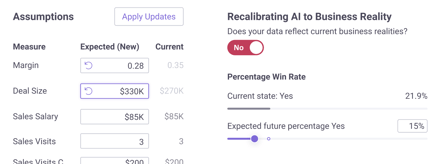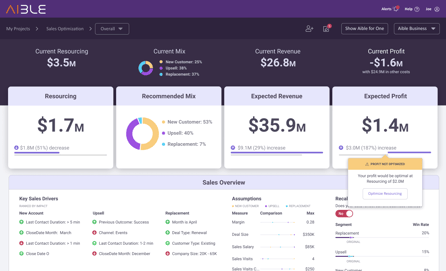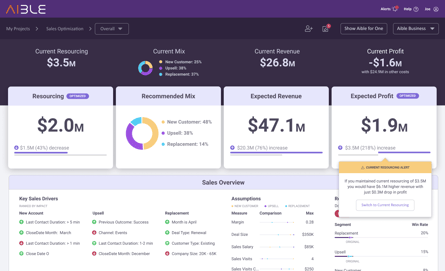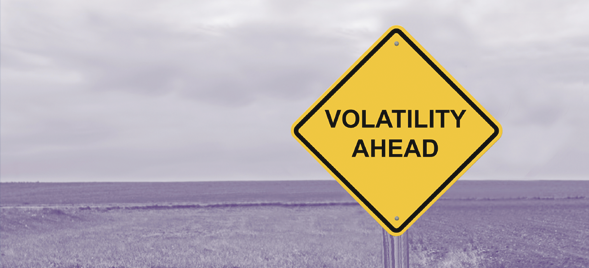See How AI Can Help Your Business Make Tough Choices.
The world has changed overnight and all of your previous business assumptions are suddenly out of date. Everything from cost-per-click to deal size is fundamentally different and likely to keep changing over the coming months.
What’s needed is an AI that can respond automatically to shifting business conditions to help businesses navigate uncertain times. Aible analyzes the impact of rapidly changing business assumptions and delivers an efficient frontier of dynamically-balanced models that are optimized for a wide range of potential business realities. Those optimizations are further refined by end user feedback, which acts as a proxy for data in order to inform business strategy. Models are continuously monitored to see if business outcomes match predictions in order to guide focused retraining and the selection of new models.
Human knowledge and AI working together in this way are far superior to either one acting alone. In the face of economic uncertainty, humans don’t have the capacity to consider thousands of competing factors and AI alone can’t make informed predictions based on completely out-of-date data. Aible empowers humans to integrate adjustments in business assumptions into what the AI has learned, creating a powerful engine for informed decision making.
It’s uncertain whether the economy is headed for a long or brief recession. But it’s already clear that businesses can expect an extended period of economic uncertainty in the weeks and months to come. Businesses need help to navigate these times of economic uncertainty, when making the right decisions can mean the difference between managing a recession and being overwhelmed by it.
The dramatic changes are challenging the ability of AI to make useful predictions about the future. Every AI is based on data that it’s already seen. But the economic disruption we face today is significantly changing the way people behave, and the “new normal” is not reflected in the old data. For example, the airline industry’s expectations of travel and vacation patterns are completely out-of-date. Demand patterns for consumer packaged goods are dramatically different. Yesterday’s inventory assumptions bear no resemblance to today’s realities.
Those are only obvious changes. Peoples’ behavior is changing in more subtle ways as well. If you’re working from home, you might look at websites that are different than the ones you usually visit. An advertiser trying to reach you with an online ad is going to have to change the way they target you. Some business owners will change their buying patterns for replacement parts for major equipment because they had to shut down their plant. Other businesses might try to completely hunker down and delay purchases as long as they possibly can.
One thing is certain – all business assumptions about behavior we had a few months ago are now completely different, in ways that aren’t completely clear. That being the case, how can any AI that was trained on historical data and patterns be effective?
In the face of economic uncertainty, one course of action for a businessperson is to wait to adopt AI until a “new normal” takes hold. But given the current rate of disruption, the economy might not be in a new normal for several years. And even if the economy achieves a new normal anytime soon, it’s unlikely to look anything like the old normal.
Waiting for business conditions to stabilize before adopting AI is precisely the wrong strategy to take in uncertain economic times. The great advantage of automation and machine learning is the ability to make many micro-adjustments to changing situations at a scale that can’t possibly be done manually. Optimized AI can analyze business impact under a wide range of business assumptions and adjust automatically as market conditions change. This sort of dynamically-balanced AI can not only help a business weather a downturn but also give it an advantage as the economy improves.
When a downturn hits, businesses typically make the same kinds of bad decisions in the face of change. They wait too long to react to changing market conditions, hoping they can ride out a dip without making major changes. Then once it’s clear that a downturn is taking hold, businesses over-react. They dramatically shrink headcount, close offices, shut down production lines, cut back inventory, and hunker down. Not only is the reaction too much and too late, businesses often over-correct in the wrong places. Areas of the business that have high marginal profit may lose staff while departments with lower margins maintain the same resourcing.
Eventually, when the economy starts to recover, businesses slowly add a few more resources – but not nearly enough to take advantage of the emerging growth opportunity. These businesses make the wrong move at every step in the economic cycle. Far from riding the economic curve, the curve rides them.
Let’s take a closer look at exactly how this plays out during a downturn – first in sales, and then in marketing.
Before we do that, some may question why we’re talking about sales and marketing at all in the face of a global pandemic. But the fact is, business executives have a responsibility to their teams to navigate economic uncertainty and end up in a place where the company is strong and people still have jobs. For business leaders, doing nothing isn’t an option. At the same time, executives shouldn’t make drastic changes without carefully thinking through how it affects the people who depend on the business for their livelihood. Decisions about sales and marketing play a key role in how businesses and employees weather an economic downturn.
Let’s look at a sales example.
A CEO facing lower economic activity decides to reduce costs by more than half, from a resourcing level of $3.5M (which represents 35 salespeople) to $1.7M (17 salespeople). What typically happens is that the CEO tries to spread that pain evenly across the organization so that everyone shares the burden. That seems fair, but it’s actually the wrong approach. If you cut 50% across the board, you have no idea whether you’re cutting fat or muscle.
Now, assume we decide to make a 50% cut in sales resourcing. And also assume that the company has three main sales channels – new product sales (25% of overall), replacement parts sales (37% of overall), and upsell accounts (38% of overall). And we decide the sales cost reductions will be split equally across the departments.

However, all three sales functions are very different, with their own unique assumptions. To navigate in these uncertain times, we need to figure out what our future looks like under different business assumptions. We also need to remember that in addition to assumptions changing during economic uncertainty, behavior changes. To account for that, we can dial in a dampener. We say that based on my human intuition and knowledge of the market, people are 30% less likely to buy than they were before and let the AI make the appropriate adjustments. By adding human expertise and knowledge, the AI can incorporate that into scenario planning.
Now let's see that in action:
Similarly, let’s say that in the case of replacement parts, we expect a 10% slowdown in the market. We also know that our in-person service expenses will likely go up somewhat because the business might have to make special health protections for the installation staff, so we make appropriate adjustments to our margin expectations. For new accounts, on the other hand, we expect a 30% reduction in our business because people are very distracted and want to avoid capital expenses where they can. So we will have to make significant concessions and still face significantly lower win rates.

For upsell, we know that people are going to delay their expenses but we believe if we go to existing customers and give them a discounted offering they might be willing to buy today. In fact, they may do slightly bigger deals (average of $330K instead of $270K) but at a lower margin of 28% instead of the original 35%. At the same time, we believe that our upsell success rate is going to reduce from about 22% to just 15%. We’re going to do bigger but less profitable deals and far fewer of them. Those are all assumptions we can account for, drawing on our knowledge of the market.
 Now, let’s go back up to the top and say I still want to cut my sales costs in half. But when we look at the changed business assumptions and make those adjustments, it actually turns out that now 53% of my effort should be going into new accounts, 40% should be going into upsell, and only 7% of effort should be going into replacement sales – a dramatically different split. I still made the same 50% cut in my overall sales expense as before, but the new allocation delivers a far better economic outcome.
Now, let’s go back up to the top and say I still want to cut my sales costs in half. But when we look at the changed business assumptions and make those adjustments, it actually turns out that now 53% of my effort should be going into new accounts, 40% should be going into upsell, and only 7% of effort should be going into replacement sales – a dramatically different split. I still made the same 50% cut in my overall sales expense as before, but the new allocation delivers a far better economic outcome.
 Now you’re better off economically by reallocating your cuts. But is a 50% sales cut the optimal reduction? Maybe it’s not. So, let the AI look at a range of different cuts – 10%, 15%, 20%, 30% – and see what the impact is. Here it suggests that a resourcing level of $2M (a 43% decrease from current resourcing) is optimal. If I cut beyond this $2M resourcing level, I start to see a precipitous overall drop in business for every dollar of cut. In fact, by adding back just three more salespeople and readjusting our focus among the three businesses (48% on new customers, 38% on upsell and 14% on replacement parts), I can increase my revenue by $11M and profits by $0.5M.
Now you’re better off economically by reallocating your cuts. But is a 50% sales cut the optimal reduction? Maybe it’s not. So, let the AI look at a range of different cuts – 10%, 15%, 20%, 30% – and see what the impact is. Here it suggests that a resourcing level of $2M (a 43% decrease from current resourcing) is optimal. If I cut beyond this $2M resourcing level, I start to see a precipitous overall drop in business for every dollar of cut. In fact, by adding back just three more salespeople and readjusting our focus among the three businesses (48% on new customers, 38% on upsell and 14% on replacement parts), I can increase my revenue by $11M and profits by $0.5M.
Thanks to AI that optimizes for changing business assumptions, I can make truly informed resourcing decisions. Making a 50% cut across the board turned out to be a bad decision. Adjusting the allocation of that 50% cut across different sales opportunities was a much better decision. But adjusting the overall cut to 43% with the appropriate allocation was the best choice of all. And I can see the expected economic impact on my business in each of the scenarios. By making the optimal choice, I’m in a much better economic state to weather the downturn and emerge stronger at the other end.
As new data starts coming in, you’ll start getting feedback from salespeople. Some salespeople might say that they want the AI to be more conservative because the AI is sending them too many leads that aren’t converting. Other salespeople might find that the AI is not aggressive enough, it’s telling them to go after too few deals and they need to have more leads. As a consequence, salespeople in different regions and for different product types will start shifting to a more aggressive or more conservative model depending on their individual market realities. That human feedback from the front line enables you to rebalance your strategy. You’re using user feedback and human intuition as a proxy for what you really want to get at – updated data.
Once you start monitoring predictions, over time, you’re going to see whether or not the predictions were right. You’ll start collecting a training data set based on the new behavior, and at some point, you’ll get enough data to retrain the AI. You may also take data for the “new normal” in one region and use it as a proxy to adjust the AI for a different region. For instance, you can take the change in consumer behavior for Italy, which for a time was ahead of the US in the emergence of Covid-19, and apply it to U.S. business assumptions. In that way, you can take an AI trained on a data set for one region and have it be a proxy for how another region is going to play out.
In this way, Aible delivers a 1-2-3 punch. One, by letting you do extensive scenario testing, Aible enables you to make much better-balanced decisions. Two, by enabling end user feedback, you can make many micro-adjustments as new market realities are revealed. Three, as enough data is collected from the new reality, Aible knows when and how it needs to be retrained and adjusted.
Now let’s look at a marketing example.
Let’s say I have three major types of marketing activities. One is events, another is Google AdWords, a third is social media. And let’s say I decide that the marketing budget has to be cut by 15%. One of the things I know right away is that my events budget, which used to be 50% of the allocation, is going to be drastically reduced because all in-person events have been cancelled for at least the next three months. I can’t take out all of the events budget because I have some commitments I have to spend later in the year, but I’m going to reduce the events budget to zero for the next quarter.
It’s not just your events that are going to change. Your AdWords cost-per-click will change because competitors may be running more ads or fewer ads. Maybe your social media effectiveness is going to change because in the industry you’re in, people will be doing less social media activity, or if you’re in healthcare, they may be doing much more social media activity.
So how do I figure out how to reallocate my marketing budget given all of these changes? Given your shifting assumptions, you need to come up with a completely different mix than a 15% across-the-board cut in marketing. You want to try a lot of different scenarios because different people will have different assumptions about what is likely to happen. With Aible, you can test all of those assumptions and see how it affects your scenario planning.
When you actually deploy the AI, you do so knowing that those assumptions will end up being wrong at some point. Your expectations about cost-per-click and social media effectiveness are going to change. What you do is deploy an efficient frontier of dynamically balanced models that are optimized for a wide range of possible scenarios. If your cost-per-click turns out to be 30% lower than expected, or 50% higher, the system will automatically use the optimal AI for that situation to figure your winning strategy. You don’t have to go in and retrain the AI. Aible creates a portfolio of models that cover not only the scenarios that you’ve thought of, but also thousands of other scenarios extrapolated from the ones that you’ve picked. That way, the right model always gets used for the right business reality.
You can also go back and consider your sales and marketing efforts in tandem and the way they interact. If sales are moving quickly into renewals instead of new accounts, and you cut sales by 15%, you might want to cut marketing by 25% until the economy recovers.
Aible is founded on the belief that human knowledge and AI working together are far superior to either one acting alone. In the face of major economic uncertainty, humans alone are likely to pull one big lever, make big cuts across the board and hope for the best. Humans don’t have the capacity to consider thousands of competing factors. On the other hand, AI alone can’t make informed predictions and recommendations in a sudden downturn because it’s dealing with completely out-of-date information. But when humans are empowered to combine adjustments in business assumptions with what the AI has learned, it creates a powerful engine for informed decision making. And in these uncertain times, making smarter data-driven business decisions is more important than ever.


